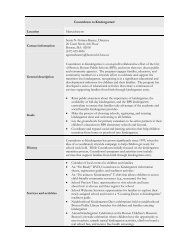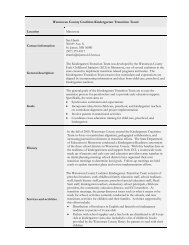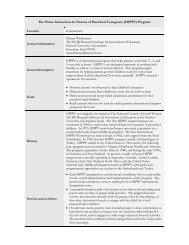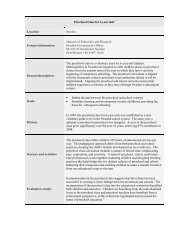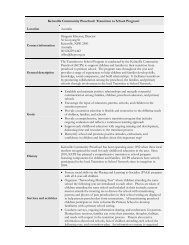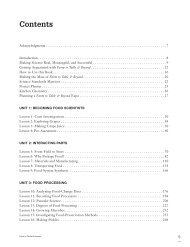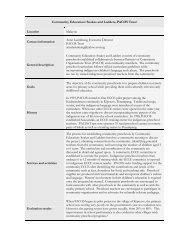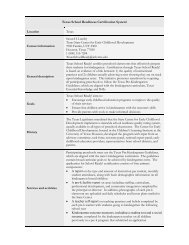Proceedings of the Fourth Annual Teachers College Educational ...
Proceedings of the Fourth Annual Teachers College Educational ...
Proceedings of the Fourth Annual Teachers College Educational ...
You also want an ePaper? Increase the reach of your titles
YUMPU automatically turns print PDFs into web optimized ePapers that Google loves.
Applying Physics to <strong>the</strong> Real World: Using Embodiment and LEGO<br />
Mindstorms in Physics Learning for Children<br />
Carol M. Lu, Seokmin Kang, Sorachai Kornkasem, Laura M. Lu,<br />
<strong>Teachers</strong> <strong>College</strong>, Columbia University, 525 W. 120 th St., New York, NY 10027<br />
Email: cml2133@columbia.edu, sk2587@tc.columbia.edu, sk451@columbia.edu,<br />
lml2152@columbia.edu<br />
Abstract: This study examined elementary students’ ability to apply physics concepts in<br />
real world situations through <strong>the</strong> use <strong>of</strong> embodiment and LEGO Mindstroms. Participants<br />
in this study included fifth graders from an inner-city public elementary school where <strong>the</strong>y<br />
were randomly assigned to ei<strong>the</strong>r LEGO robotics instruction with embodiment or LEGO<br />
robotics instruction without embodiment. Both groups were asked to complete a set <strong>of</strong><br />
prescribed tasks pertaining to physical science. In addition, students in <strong>the</strong> embodiment<br />
group were asked to act like robots and moved <strong>the</strong>ir own bodies based on <strong>the</strong><br />
instructions given for <strong>the</strong> tasks. Students in both groups were asked to take a pretest<br />
and <strong>the</strong>n a posttest and short interview to assess <strong>the</strong> learning outcomes at <strong>the</strong> end <strong>of</strong> our<br />
study. The results revealed that students with embodied experiences were able to apply<br />
physics concepts in o<strong>the</strong>r contexts better than those without embodiment.<br />
Many cognitive scientists have developed an increased interest in exploring how mind and body<br />
collaborate to develop better understanding through embodied cognition in different contexts and settings.<br />
Recent literature suggests that we generate multimodal representations that are grounded on <strong>the</strong> physical<br />
experiences we gain through different sensory modalities as well as emotional conditions when we<br />
interact with <strong>the</strong> world (Barsalou, 2008). Meanwhile, robots provide “students opportunities to represent<br />
<strong>the</strong>ir ideas in different ways and utilize 3D artifacts (robots) to contextualize <strong>the</strong>ir learning and help <strong>the</strong>m<br />
communicate <strong>the</strong>ir ideas and understandings (Church et al., 2010, p. 47). Papert (1980) claims that<br />
learning with robotics transforms <strong>the</strong> way students learn. That is, robotics helps students associate <strong>the</strong><br />
knowledge <strong>the</strong>y learn in <strong>the</strong>ir minds and <strong>the</strong> knowledge <strong>the</strong>y build with <strong>the</strong>ir hands, using robots. This<br />
knowledge children acquire is valuable, as <strong>the</strong>y will be using and creating new meaning based on that<br />
understanding.<br />
This study examined elementary students’ ability to apply physics concepts in real world situations such<br />
as sports through <strong>the</strong> use <strong>of</strong> embodiment and LEGO Mindstroms. We designed an after-school program<br />
integrating embodied cognition with LEGO robotics to assess whe<strong>the</strong>r students’ ability to apply physics<br />
concepts increase when <strong>the</strong>y physically move <strong>the</strong>ir own bodies in activities related to science and sports.<br />
Participants in this study included fifth graders from an inner-city public elementary school where <strong>the</strong>y<br />
were randomly assigned to ei<strong>the</strong>r LEGO robotics instruction with embodiment or LEGO robotics<br />
instruction without embodiment. Both groups were asked to complete a set <strong>of</strong> prescribed tasks pertaining<br />
to physical science. In addition, students in <strong>the</strong> embodiment group were asked to act like robots and<br />
moved <strong>the</strong>ir own bodies based on <strong>the</strong> instructions given for <strong>the</strong> tasks. Students in both groups were<br />
asked to take a pretest and <strong>the</strong>n a posttest and short interview to assess <strong>the</strong> learning outcomes at <strong>the</strong><br />
end <strong>of</strong> our study.<br />
Although our curriculum had an overall effect on both control and experimental group in terms <strong>of</strong> science<br />
application and understanding, <strong>the</strong> results <strong>of</strong> our study revealed that students with embodied experiences<br />
were able to apply physics concepts in o<strong>the</strong>r contexts better than those without embodiment. Previous<br />
studies have indicated that children typically find science concepts abstract and very hard to grasp<br />
(Johnstone, 1991; Millar, 1991). The findings <strong>of</strong> our study suggest that integrating embodiment with<br />
LEGO robotics can improve students’ ability to transfer <strong>the</strong>ir understanding <strong>of</strong> physics concepts in ano<strong>the</strong>r<br />
context. Additional research should be done to identify <strong>the</strong> generalizability <strong>of</strong> <strong>the</strong>se findings to o<strong>the</strong>r<br />
populations and learning content.<br />
44



